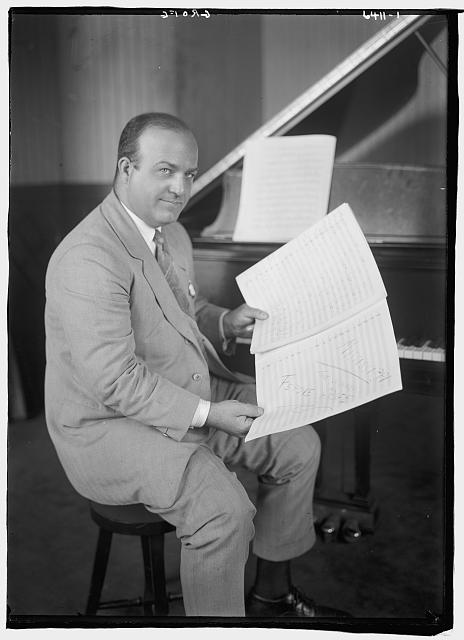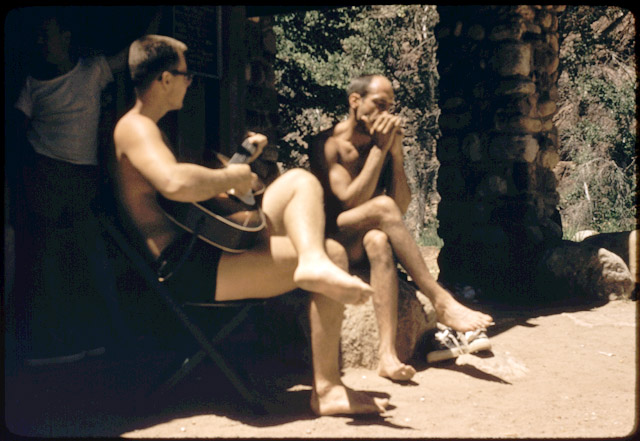The Grand Canyon inspires a rainbow of emotions and reactions in visitors. Some reach for their pens in an attempt to describe its impact using words; others grab their paintbrushes to try to capture its impressions visually. For others, the magic and majesty of the landscape and its inhabitants is best conveyed musically. The Canyon has not only inspired the composition of musical works, but has also served as the background for musical festivals and performances.
For several decades at the beginning of the 20th Century, performances by a “cowboy orchestra” at El Tovar were one of the main nightly attractions for visitors. Whether the orchestra was made up of local cowboys and mule wranglers, or whether it performed “cowboy” music, or both, isn’t exactly clear, but it was popular enough among visitors to keep them coming back for many years. As time moved on and musical tastes diversified, concessionaires at the park adapted; during the WWII years musicians played big band music at the community center where visiting military personnel brought their dance partners to swing the night away.
In 1934, local citizens organized the first annual Easter Sunrise Service, a non-denominational religious ceremony that still takes place today. Organizers began inviting choirs from the state’s colleges to sing inspirational hymns for the worshippers, and many of these performances were broadcast over national radio.
Musicians have also figured prominently in ceremonies and seasonal events at the Canyon. For example, for decades Hopi drums and singing accompanied dancers who entertained crowds at Hopi House nearly every night in the summertime until 1972.
In 1983, on a hike through the Canyon, Robert Bonfiglio and Clare Hoffman were asked to give an impromptu concert at the Cottonwood Campground below the North Rim for a retiring ranger. The enthusiasm that visitors and the local community expressed for this event inspired them to organize the first Grand Canyon Music Festival in 1984, which featured concerts by three musicians. Today the event has grown into a three-week event with several separate concerts held at the Shrine of the Ages. The festival has featured a variety of music written by local and national artists, ranging from solo performances on a variety of instruments to large chamber ensembles. In 2001, the festival began a Native American Composers Apprentice Project to nurture the musical talents of local Native American students, culminating in an opportunity to perform their work at the festival.
Music written about the Canyon contains many themes, including songs of boatmen and river guides, instrumental solos conveying the solitude and mystery of the Canyon walls, the lyrical cowboy poetry sung and recited by mule train leaders and packers, Native American songs that tell about everyday life in the region, and songs celebrating the nature and wildlife of the area. However, one of the most famous and enduring pieces of music inspired by the Grand Canyon is Ferde Grofe’s Grand Canyon Suite.
In 2000, National Public Radio named Grand Canyon Suite one of the 100 most important American musical works of the 20th Century. Its composer, Ferdinand “Ferde” Grofe, was born in 1892 in New York into a family of fiddlers who had come to the United States from Germany. He dropped out of school at 13, traveling across the country performing odd jobs.
Grofe first arrived at the Grand Canyon in 1916. He recalled that he had arrived at the Canyon at night and set up camp, so that his first experience of it would come at the next sunrise. He remembered the experience distinctly many years later, saying, “I was spellbound by the silence; but then as it got lighter and brighter, you could hear the birds chirping and nature coming to life. All of a sudden, bingo! There was the sun. I could hardly describe it in words.”
Grofe gained experience working with some of the premier composers in American music in the 1920s, including George Gershwin. Fifteen years after his first glimpse of the Canyon, he completed his landmark musical suite, which he first titled “Five Pictures of the Grand Canyon.” The five “pictures” or movements are Sunrise, Painted Desert, On the Trail, Sunset, and Cloudburst. This work is representative of the flowering musical scene of the early 20th century in which American composers experimented with combining various old and new musical forms to establish a uniquely American sound. In this case, Grofe experimented with combining classical and jazz musical forms.
Being familiar with every instrument in the orchestra, Grofe used them to mimic the sounds of nature he heard at the Canyon, such as using woodwinds to represent birds. He experimented with sound effects in innovative ways, such using coconut shells to imitate the hoofbeats of a loping burro, as much to evoke mental pictures as aural impressions. Many of his works focused on using music to create moods reflective of natural landscape features, such as his Mississippi Suite, Yellowstone Suite, Valley of the Sun Suite, and Dawn at Lake Mead.
The tobacco company Philip Morris used the “On the Trail” movement as its musical signature in radio and television programs it sponsored beginning in 1933. In 1958 the Walt Disney Company produced an Academy Award-winning short film entitled Grand Canyon that was “a pictorial interpretation of Ferde Grofe’s Grand Canyon Suite.” The film had no plot or dialogue, just three movements of the suite playing in the background. It was shown to audiences who came to see Sleeping Beauty during its initial big screen release, and today is included with DVD re-releases of that film, which means the Grand Canyon and Grofe’s musical interpretation of it are constantly being introduced to new generations.
The Grand Canyon Suite has been called a symphonic poem, or a musical work meant to convey a literary story. For instance, “On the Trail,” perhaps the best-known of the movements, tells the story of a cowboy on a burro descending a trail into the Canyon. Along the way listeners hear him pass a waterfall, stop at a cabin with a music box to rest, and then continue on down the trail at a livelier pace.
Musicians today continue to write music evoking the grandeur, solitude, and sensations of the Canyon, as the dozens of CDs available in park book stores can attest. With the park’s natural symphony of rustling trees, chirping birds, buzzing insects, roaring waters, and awesome thunderstorms, combined with mesmerizing vistas and other almost magical phenomena, how could they not be inspired?
Written By Sarah Bohl Gerke
For further information see:
- The NPR 100. Grand Canyon Suite. Available online at www.npr.org/programs/specials/vote/list100.html.
- Grand Canyon Music Festival. www.grandcanyonmusicfest.org.






